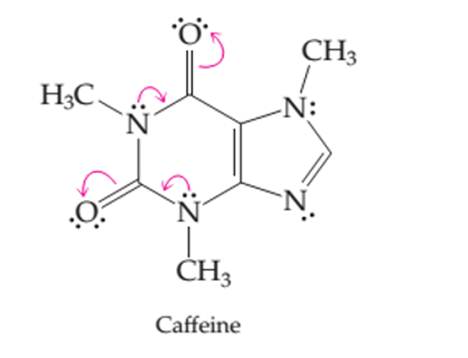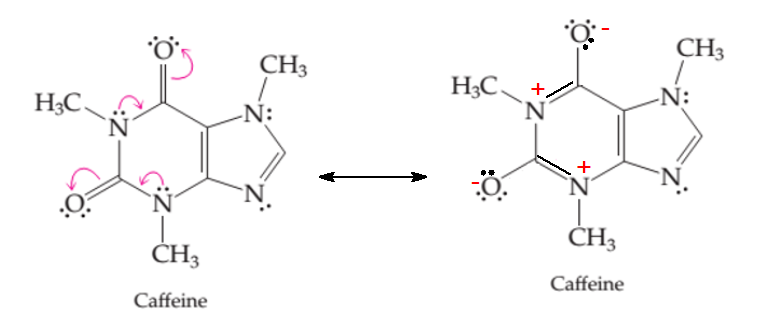
Concept explainers
(a)
Interpretation:
The resonance structure that results from the given arrow in the caffeine molecule needs to be determined.

Concept introduction:
Organic compounds are the compounds which are mainly composed C and H atoms. The branch of chemistry that deals with preparation, reactions, and properties of organic compounds. The molecular formula of organic compound represents the number of bonded atoms with their atomic symbols.
(b)
Interpretation:
Thehybridization of each C and N in two rings of caffeine molecule in its resonating structures needs to be determined.

Concept introduction:
Organic compounds are the compounds which are mainly composed C and H atoms. The branch of chemistry that deals with preparation, reactions, and properties of organic compounds. The molecular formula of organic compound represents the number of bonded atoms with their atomic symbols.
Functional groups are the groups of atoms or atoms which are bonded with parent carbon chain in the organic molecule and are responsible for the physical and chemical properties of the compound. In organic chemistry, there are different functional groups such as carboxylic acid, alcohol, ester, or amide.
(c)
Interpretation:
Thearomatic nature of caffeine molecule needs to be explained.

Concept introduction:
Organic compounds are the compounds which are mainly composed C and H atoms. The branch of chemistry that deals with preparation, reactions, and properties of organic compounds. The molecular formula of organic compound represents the number of bonded atoms with their atomic symbols.
Functional groups are the groups of atoms or atoms which are bonded with parent carbon chain in the organic molecule and are responsible for the physical and chemical properties of the compound. In organic chemistry, there are different functional groups such as carboxylic acid, alcohol, ester, or amide.
Want to see the full answer?
Check out a sample textbook solution
Chapter 23 Solutions
CHEMISTRY-TEXT
- Draw the shapes of the following molecules and ions in 3-dimension. Show clearly any lone pairs of electrons on the central atom, state the number of bond pairs and lone pairs of electrons on the central atom and name the shape of the molecule or ion. (a) CH3+, methyl carbocation (b) HOBr, bromic (I) acid (c) NCl3, nitrogen trichloride Provide everything stated in the instructions for each compound.arrow_forwardConsider compounds A–D, which contain both a heteroatom and a double bond. (a) For which compounds are no additional Lewis structures possible? (b) When two or more Lewis structures can be drawn, draw all additional resonance structures.arrow_forwardDraw the shapes of the following molecules and ions in 3-dimension. Show clearly any lone pairs of electrons on the central atom, state the number of bond pairs and lone pairs of electrons on the central atom and name the shape of the molecule or ion. (a) PH4+, phosphonium ion (b) PBr5, phosphorus pentabromide (c) H3O+, oxonium ion Provide everything stated in the instructions for each compound.arrow_forward
- The partial Lewis structure that follows is for a hydrocarbonmolecule. In the full Lewis structure, each carbon atomsatisfies the octet rule, and there are no unshared electronpairs in the molecule. The carbon—carbon bondsare labeled 1, 2, and 3. (a) How many hydrogen atomsare in the molecule? (b) Rank the carbon–carbonbonds in order of increasing bond length. (c) Whichcarbon—carbon bond is the strongest one? [Sections 8.3and 8.8]arrow_forwardThe partial Lewis structure that follows is for a hydrocarbonmolecule. In the full Lewis structure, each carbon atomsatisfies the octet rule, and there are no unshared electronpairs in the molecule. The carbon—carbon bondsare labeled 1, 2, and 3. (a) How many hydrogen atomsare in the molecule? (b) Rank the carbon–carbonbonds in order of increasing bond length. (c) Whichcarbon—carbon bond is the strongest one?arrow_forwardCompute the formal charge (FC) on each atom in the following structures.(a) Methane (CH4)arrow_forward
- Chemistry (a) Write three more resonance structures for each of compounds 1 and 2. (b) In each of compounds 1 and 2, determine which resonance structure contributes the most and explain your answer. (c) Are the 3/4 structures resonance structures or different compounds? Same question for 5/6 structures. Explain your answers.arrow_forward(a) Triazine, C3 H3 N3, is like benzene except that in triazineevery other C¬H group is replaced by a nitrogen atom.Draw the Lewis structure(s) for the triazine molecule. (b) Estimatethe carbon–nitrogen bond distances in the ring.arrow_forward(a) Triazine, C3 H3 N3, is like benzene except that in triazineevery other C¬H group is replaced by a nitrogen atom. Draw the Lewis structure(s) for the triazine molecule. (b) Estimatethe carbon–nitrogen bond distances in the ring.arrow_forward
- Consider compounds A–D, which contain both a heteroatom and a double bond. (a) For which compounds are no additional Lewis structures possible? (b) When two or more Lewis structures can be drawn, draw all additional resonance structures.arrow_forwardDraw a Lewis Structure for each of the following species and assign formal charge where appropriate. Using electronegative values from the period table that was provided identify polar covalent bonds and label the atoms δ+ and δ−. For each of the molecules indicate whether or not it has a dipole moment. (a)CH5N (b) HCN (c) H2CO (d) CH3NC(e) CH3SOCH3 (f) H6BNarrow_forwardWrite Lewis structures for these compounds. Show all valence electrons. None of them contains a ring of atoms. (a) Hydrogen peroxide, H2O2 (b) Hydrazine, N2H4 (c) Methanol, CH3OHarrow_forward
 ChemistryChemistryISBN:9781305957404Author:Steven S. Zumdahl, Susan A. Zumdahl, Donald J. DeCostePublisher:Cengage Learning
ChemistryChemistryISBN:9781305957404Author:Steven S. Zumdahl, Susan A. Zumdahl, Donald J. DeCostePublisher:Cengage Learning ChemistryChemistryISBN:9781259911156Author:Raymond Chang Dr., Jason Overby ProfessorPublisher:McGraw-Hill Education
ChemistryChemistryISBN:9781259911156Author:Raymond Chang Dr., Jason Overby ProfessorPublisher:McGraw-Hill Education Principles of Instrumental AnalysisChemistryISBN:9781305577213Author:Douglas A. Skoog, F. James Holler, Stanley R. CrouchPublisher:Cengage Learning
Principles of Instrumental AnalysisChemistryISBN:9781305577213Author:Douglas A. Skoog, F. James Holler, Stanley R. CrouchPublisher:Cengage Learning Organic ChemistryChemistryISBN:9780078021558Author:Janice Gorzynski Smith Dr.Publisher:McGraw-Hill Education
Organic ChemistryChemistryISBN:9780078021558Author:Janice Gorzynski Smith Dr.Publisher:McGraw-Hill Education Chemistry: Principles and ReactionsChemistryISBN:9781305079373Author:William L. Masterton, Cecile N. HurleyPublisher:Cengage Learning
Chemistry: Principles and ReactionsChemistryISBN:9781305079373Author:William L. Masterton, Cecile N. HurleyPublisher:Cengage Learning Elementary Principles of Chemical Processes, Bind...ChemistryISBN:9781118431221Author:Richard M. Felder, Ronald W. Rousseau, Lisa G. BullardPublisher:WILEY
Elementary Principles of Chemical Processes, Bind...ChemistryISBN:9781118431221Author:Richard M. Felder, Ronald W. Rousseau, Lisa G. BullardPublisher:WILEY





